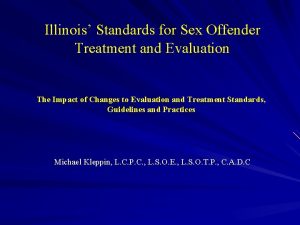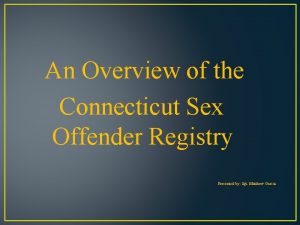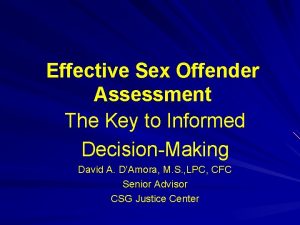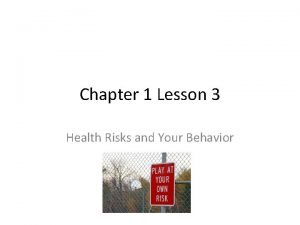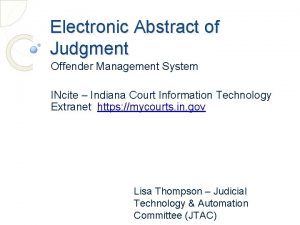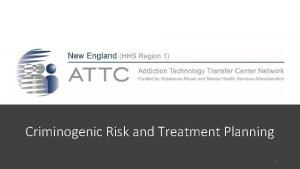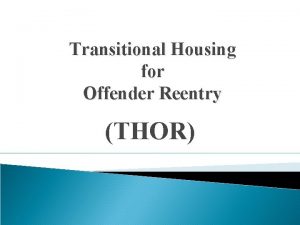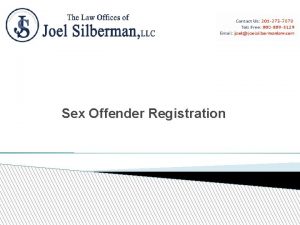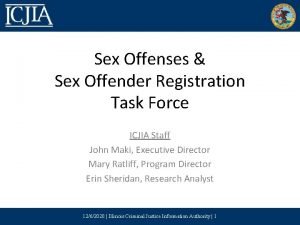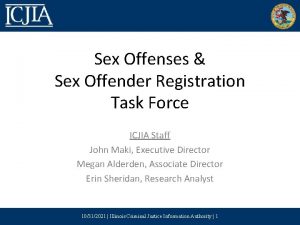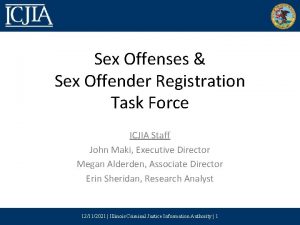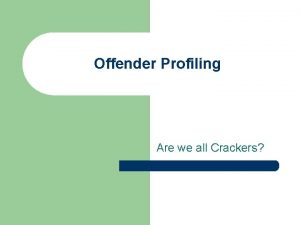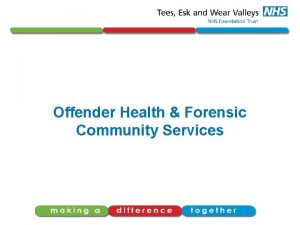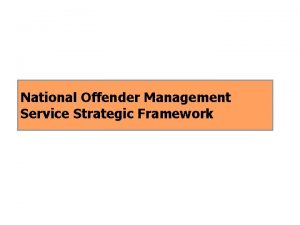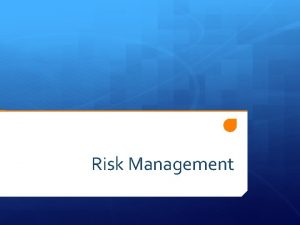The Dynamic Risk Guide Identifying sex offender risks

























- Slides: 25

The Dynamic Risk Guide Identifying sex offender risks and using tools to enhance skills and address interventions. SOUP Group-OSCI October 17 th, 2019

What are the Principles of Effective Interventions? Risk Need Responsivity Who? What? How?

What are agents currently looking at to address sex offender needs and reduce their risk?

Effective Interventions What does the offender need to target the problem? What about the specific sex offender needs? Top 4 Criminogenic Need areas: Anti-social Cognition Anti-social Personality Anti-social Peers Family/Marital How are we incorporating the Dynamic Risk Factors into our interventions?


What can we do to continue to build the bridge?

Initial survey says……. . 11 agents were surveyed and the following results were found: • 78% of agents asked were not currently structuring appointments around dynamic risk factors • 78% revealed they did not feel confident in skill building around dynamic risk factors of sex offenders. • 67% of the agents indicated they did not have a guide to link the needs with the tools for either skill building or providing interventions specific to sex offenders

What is the Dynamic Risk Guide? A newly developed tool that correlates known predictors of sexual recidivism to criminogenic needs which aid agents in determining the most appropriate intervention for sex offenders

Dynamic Risk Factors What are dynamic risk factors? Stable dynamic risk factors are statistically relevant personality characteristics, skill deficits, and learned behaviors that relate to risk for sexual recidivism that may be changed through intervention Why are they important? Assist agents to focus on relevant risk factors and ignore those that are not related to the risk of sexual re-offending Address key questions such as “What should I target? ” and “When should I intervene? ”

Stable 2007 Significant Social Influences Intimacy Deficits • Capacity for relationship stability • Emotional identification with children • Hostility towards women • General social rejection/loneliness • Lack of concern for others Sexual Self-Regulation • Sexual drive/pre-occupation • Sex as coping • Deviant sexual interest General Self-Regulation • Impulsive acts • Poor cognitive problem solving • Negative emotionality/hostility Cooperation with Supervision

Acute Risk Factors Victim access Sexual preoccupation Hostility Rejection of supervision Emotional collapse Collapse of social supports Substance abuse

The Dynamic Risk Guide Anti-social Cognition Offense supportive attitudes Grievance/Hostility to Women Machiavellianism combines Anti-Social Associates Family Emotional Congruence w/ Children Lack of Emotional Relationships w/ Adults Negative Social Relationships Callous/Lack of Concern for Others

The Dynamic Risk Guide Anti-social Personality Lifestyle Impulsiveness Poor Problem Solving Resistant to Rules/Supervision Dysfunctional Coping Sexual Interests Sexual Interest in Children (13 or younger) Sexual preoccupation Sexualized violence Multiple paraphilia

The Dynamic Risk Guide Progression DRG concept approved by Region 8 Chief Early June DRG developed from SMART Grant interactions Late June DRG introduced to eleven Region 8 Agents for testing phase July 7 -10 DRG initial survey July 9 -13 July 9 Aug 15 Region 8 Trial Team de-briefing

The Dynamic Risk Guide Progression Region 8 Staff Trained and DRG may be used throughout Region DRG 2. 0 Produced Aug 23 Region 8 Chiefs were debriefed with Summary and Proposed Roll Out approved Sept 10 Sept 13 Region 8 Field Supervisors updated on Roll Out plan and introduced to the DRG as a tool Oct 11 Nov 14 Region 7 Waukesha Sex Offender Unit 710 trained on the DRG

The Dynamic Risk Guide Progression Region 5 Management Team trained Feb 26 Region 6 Management Team trained Feb 28 Region 1 Management Team trained Mar 8 Region 3 Executive Team & S/O Unit CFS’s trained Mar 12 Apr 18 Region 1 Unit 104 and 112 Sex Offender Units trained

Final survey results after using the Dynamic Risk Guide…. . 73% of the participants indicated the DRG helped them in structuring their appointments around their offenders’ dynamic risks and helped raise their awareness of specific sex offender risk factors 100% of the participants reported that they felt DRG should be made available to other agents for use with the sex offender population

How do we use the DRG to improve our interventions?

When addressing skill deficits: Introduce the skill you are teaching Obtain the offender’s buy-in to the skill Teach the steps of the skill to the offender Demonstrate the steps of the skill to the offender Practice the steps of the skill to the offender Give the offender feedback about their practice with the skill

Lets try an example: An offender reports in and admits to the reports you have received on him that he has been hanging around his teenage nephews and says “They just understand me better. ” Additionally, the only other person he says he has been hanging around is the neighbor down the hall who is on Federal supervision. 1. What risk factors are standing out to you with this information? 2. What area does this fall into on the DRG? 3. What tool do you think you would use in an attempt to effectively address these risk factors?

Second example: During SOT in the community an offender in a Special Needs group reports that he feels his agent is out to get him and the agent is constantly asking questions and getting in his business. This continues over the course of several groups and is becoming disruptive to the group as a whole. This information is shared with you from the treatment provider during weekly staffings. 1. What risk factors are standing out to you with this information? 2. What area does this fall into on the DRG? 3. What tool do you think you would use in an attempt to effectively address these risk factors?

Another example: During an office visit, an offender discloses to you during an office visit that he and his live-in girlfriend regularly like to watch Elmo together and they always talk to each other like babies. Would you use the DRG for this? If so, what direction would you take it? If not, what would you do?

What scenarios have you encountered? Let’s try some real examples you have had… Ø During an Office visit? Ø During a Home Visit? Ø Jail contact?

What are the agents saying about the Dynamic Risk Guide? “This is perfect! Thanks. ” Region 8 Agent October 11, 2018 “We have been waiting for something like this on how to understand this and apply it to sex offenders” Region 7 Agent November 14 th, 2018 “We can use this in our weekly staffings to help determine better interventions. ” Region 7 Agent November 14 th, 2018

We are interested in your feedback….
 Once a sex offender always a sex offender
Once a sex offender always a sex offender Kurt bumby
Kurt bumby Sex sex sex
Sex sex sex Xxtesticles
Xxtesticles Sex sex sex
Sex sex sex Sex sex sex
Sex sex sex Prashant chopra sex offender
Prashant chopra sex offender Illinois sex offender management board
Illinois sex offender management board Sex offender registration in connecticut
Sex offender registration in connecticut Yakama nation license plate
Yakama nation license plate Interview sex offender
Interview sex offender Minnesota sex offender screening tool
Minnesota sex offender screening tool Identifying and non identifying adjective clauses
Identifying and non identifying adjective clauses Identifying and non identifying adjective clauses
Identifying and non identifying adjective clauses Identifying and non identifying adjective clauses
Identifying and non identifying adjective clauses Liquidity measures
Liquidity measures The biggest risk is not taking any risks
The biggest risk is not taking any risks Related risks that increase in effect with each added risk
Related risks that increase in effect with each added risk Sex linked traits punnett square
Sex linked traits punnett square Sex linkage
Sex linkage Sex determination and sex linkage
Sex determination and sex linkage Identifying and managing project risk tom kendrick
Identifying and managing project risk tom kendrick Indiana offender management system
Indiana offender management system What are the 8 criminogenic needs
What are the 8 criminogenic needs Offender workforce development specialist
Offender workforce development specialist Thor approved programs
Thor approved programs







